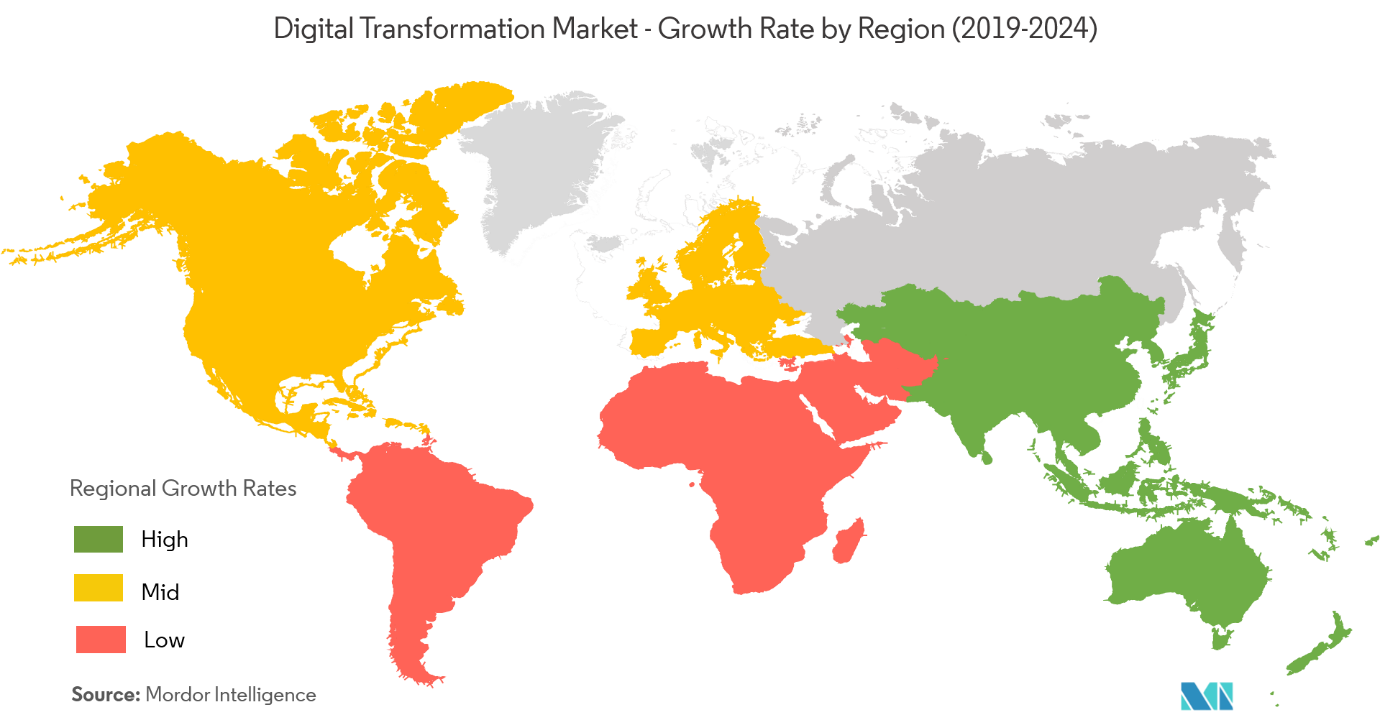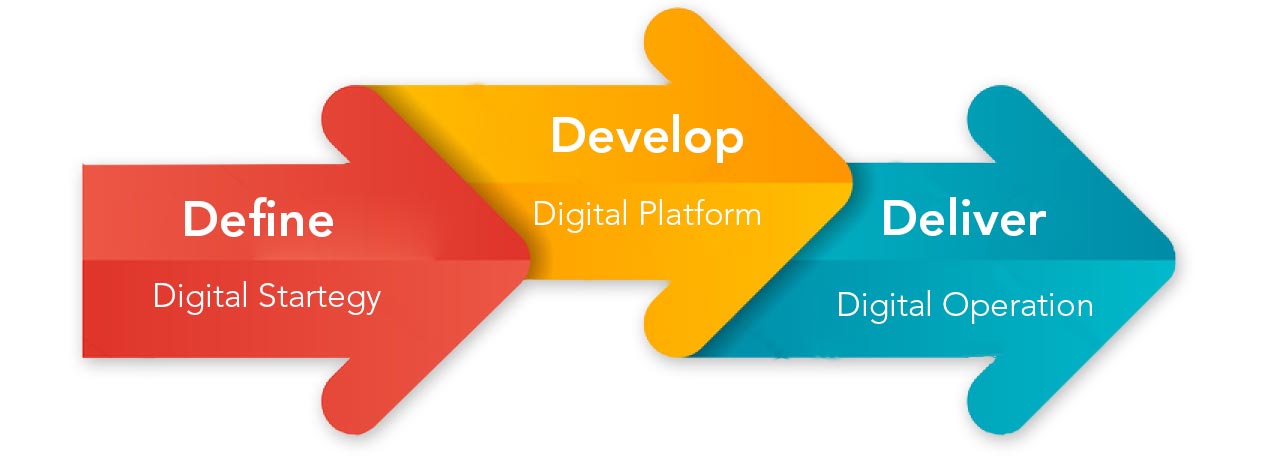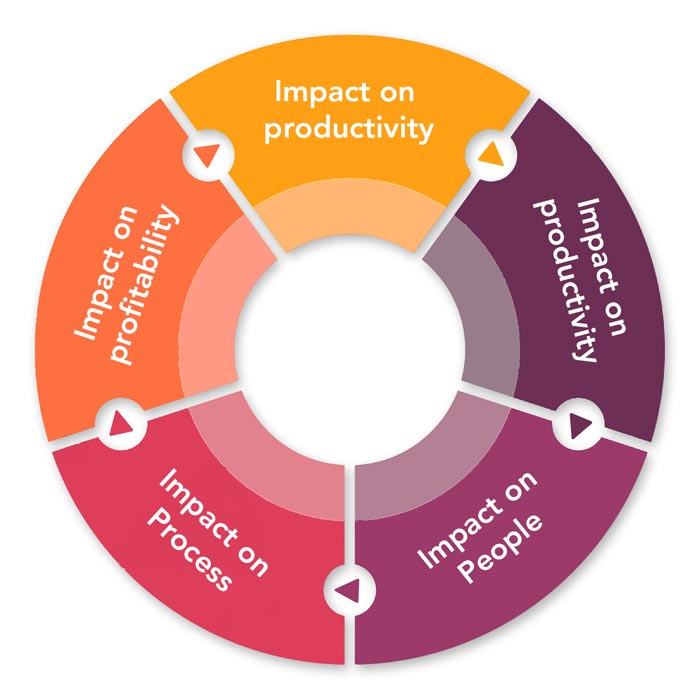Introduction
Today, traditional businesses are getting prepared for disruption from digital natives. According to IDC, global spending on digital transformation will be $2 trillion by 2022. As digital and physical worlds are merging at an alarming and accelerated pace, businesses need to start thinking about how to maximize the opportunities by leveraging new age digital technologies.
Digital Transformation is setting new standards for business growth. It is not just about incorporating newer technologies into business; it’s a digital disruption, which requires restructuring everything in the business process. As the numbers of connected devices from smartphones to cars to home automation to industrial automation to smart cities and its connection to humans are increasing, organizations that deliver digitally transformed products or services are gaining a competitive advantage over others in the market.
As per IDC, 32% of new technology investments will be driven by digital transformation, and by 2020, 60% of all enterprises will be in the stage of implementing a digital transformation strategy
By adopting smart technologies and transforming the legacy business processes, businesses will become more capable in improving customer experience, earn more trust and, as a result, increase their profit.
So what is a digital transformation? ― It is about rethinking the products and processes, digitalizing systems, and delivering highly connected and contextual experiences for the end consumers. It’s more about discovering ways by which companies can provide better digital customer experience.
Emerging technologies such as IoT, Artificial Intelligence, Virtual Reality, Augmented Reality, Big Data, Cloud Computing, and Machine Learning are predominantly changing the way businesses operate.
It’s natural to go gung-ho for advanced digital technologies, but it is equally essential to know about the digital transformation prerequisites, key drivers, complex challenges, strategies, roadmap, framework, principles, success steps, investments, ROI and benefits.
Why Digital Transformation is essential for your organization?
Digital innovation brings technological disruptions that lead to a complete transformation. Digital transformation is essential because it provides a valuable opportunity for business operations to move from legacy manual processes to digitally automated process, enabling leaders to focus on broader business opportunities. The business that has incorporated digital technology have often experienced the following:
- Significant increase in sales, and hence more revenue generation
- Significant customer acquisition, retention, and satisfaction
- Product and process improvement
- Employee satisfaction
- Increase design and engineering productivity
- Improved product quality
Businesses, of all sorts, are creating cleaver, compelling, and disruptive ways to utilize technology for customer delight. Netflix is an excellent example of digital transformation. Netflix started as a mail-order DVD distributor and disrupted the video rental market. Later, it came up with wide-scale video streaming services. Today, Netflix has taken over traditional television cable service provider and by offering on-demand content like movies, series, and videos at very competitive prices. Netflix effectively leveraged the technologies to get insights into customer preferences and provided the on-demand content to the end-user.
Key Stats

- The worldwide spending on digital technologies will be almost $2 trillion in 2022. (Source-IDC).
- The connected cars market is expected to reach $225.158 million by 2025, registering a CAGR of 17.1% from 2018 to 2025 (Sources: Allied Market Research)
- The highly digitized semiconductor industry is expected to spend around $120 billion by 2022.
(Sources: Strategy& Innovation database, 2017 Global R&D funding, Expert interviews, Strategy& analysis).
Key Drivers for Digital Transformation
The rapidly changing consumer preferences, technology, and competition gives rise to the enormous market for digital transformation. Consider an example of Uber which has completely dominated the transportation sector, forcing other taxi service providers to discover ways to incorporate similar online app-based ride experience, ride-sharing, car on rent or other on-demand services into their business. The factor behind this transformation push is technological innovation from digital-native companies like Uber.
The following are drivers of digital transformation.
1. Increasing expectation for personalized experiences
With the evolution of smart technologies, customer preferences have been evolving continuously. Today, customers are preferring product and services that are available 24/7 and that can be access from anywhere. With advent of digital technologies businesses are fulfilling the customer expectations by building smarter products that can be customized further based on specific requirements.
2. Introduction of disruptive technologies
The pace of innovation is accelerating with disruptive technologies. Internet of Things, Artificial Intelligence, Machine Learning, and Big data analytics are driving the market today. All these digital technologies are forcing businesses to change across every sector in the economy.
3. Rise in competition for digital technologies
Today, every other organization is bringing digital change in their business process as the competition level for adopting digital technologies and providing customized solutions are increasing rapidly. As per Research & Market, the global digital transformation market is expected to grow from US$ 445.4 billion in 2017 to US$ 2,279.4 billion by 2025 at a CAGR of 24.3% between 2018 and 2025.
Digital Transformation Challenges
Change comes with its own set of challenges. Digital transformation is painful when not understood properly. It becomes a complex problem when the leadership team doesn’t know what change it will bring or if the goals aren’t clearly defined.
Also, many organizations are not ready for this new reality. The legacy business models, outdated technologies, operations, resources, and skills don’t allow much scope for any new transformations.

1. Workforce Empowerment Challenges
How often you bring change to your organization? The resistance to a change can often derail the company from the current market trend. At times employees are so entrenched in the traditional processes of daily duties that they deny any changes that will take away their comfort zone.
The reason behind this could be due to the challenges it poses to their job and fear of failures. To deal with this, organizations should have an effective digital learning model in place to enhance their capabilities in implementing, adapting, and evolving with digital technologies. It is essential to empower the workforce with digital resources to carry out a successful product transformation.
2. Technology Integration Challenges
During digital transformation, you’re bringing in new digital technology to a legacy setup, and replacing outdated and non-performing processes. You’re utilizing the existing system to integrate with digital technology for bringing digital transformation. The technology integration for new process causes delays as employees face further technical training and getting accustomed to the new management techniques. Another challenge here is the cost and technical expertise required for integrating the legacy technology with the new one.
3. The Data Challenges
The data are the fuel for digital transformation. There are several challenges associated with data handling during the implementation, from data capture to storage to analysis. Organizations are finding many difficulties as they try to learn how to gain valuable insights and competitive advantages from it. The need is to gather critical data, store for a long time and use process it to produce results.
Digital Transformation Roadmap
The digital transformation strategy should clearly define and talk about the business process change, cultural change, technology change, and legacy product or service change. During updating the existing systems or adopting cutting edge technologies, enough attention must be given to the changes that will impact the business culture and the business processes.
Some of the critical steps to take for a successful digital transformation initiative:
- Keep digital transformation on top priority while crafting the business strategy
- Collect and utilize data and analytics to make business decisions
- Adopt a company-wide approach towards successful digital transformation
- Maintain the combination of both people and technology to smoothen the digital transformation process
- Monitor and control the process as and when required
For becoming successful in digital transformation, companies need to not only invest in technologies but also rethink on creating new business models, invest in digital talents, develop digital measurement matrices, and integrate automation into the workforce.
Create a Digital Business Models-. Create a lean strategic approach that helps to plan operations and support function activities. Always focus on getting relevant data and make business decisions based on data analytics. Partner with digitally capable firms and invest in emerging technologies such as IoT, ML/AI or Cloud.
Invest in Digital Talent and Skills- Is your team digitally sound? Assess the digital capabilities of the team and based on results, create a digital talent pool roadmap. Drive an organization-wide digital talent campaign and improve the skills of the workforce.
Understand and leverage data– Do not underestimate the power of data. Data are critical element for business decisions. Perform analytics on customer data, operational data, performance data, technical data, and non-technical data. Take decisions for the future, based on data analysis and business forecasting.
Automate workforce– Know the importance of automation in work culture. Automate the business process for efficient and accurate work. Automation helps in cost reduction, increasing productivity, efficiency, and performance of the team.
Digital Maturity Plan
What is digital maturity? ―Digital maturity is the ability of a company to respond appropriately to the emerging digital competitive environment. In digital journey, business assess their current capabilities that exist within an organization and help them to be clear where these need to transform or improve. In order to bring the digital change into your organization, follow the 3D approach of digital transformation.
3D Approach to Digital Transformation

1. Define
- Articulate data and define a sound strategy for transforming legacy product or service.
- Define what digital transformation means to your organization from top management to new associates.
- Set objectives and align them with the ultimate vision of the organization.
- Conduct product assessment and cost-benefit analysis.
- Set priorities and implement the change.
2. Develop
- Identify critical checkpoints/milestones regularly.
- Create change and implementation plan with definite timelines.
- Develop the risk appetite and note success factors.
- Identify roadblocks and how to overcome these challenges.
- Make digital IoT platforms to get digital insights with Machine learning and Artificial Intelligence.
- Identify opportunities and find out ways to convert them into the business.
- Invest in people skills, tools, and systems.
- Initially, maintain digital stream separate from mainstream operations.
3. Deliver
- Perform testing of transforming services or products.
- Once transformed, the technology is ready to scale for intelligent automation, OT-IT operation, and process automation.
- Monitor and control the business parameters.
- Scale the transformation to other legacy products.
- Make the process and product improvements based on the results.
Digital Transformation Framework
The framework consists of people & skills, internal operation, and technology infrastructure.

Following are core elements of the Digital Transformation Framework
People and Skills
Digital transformation isn’t just calling for a technology change, but workforce empowerment. Create a culture of innovation among the team members and look out for the people who:
- Are innovative.
- Have both flexibility and agility.
- Are great learners.
- Have good problem-solving ability.
- Are lateral thinkers.
Internal Operations
Look out for the implication of internal operations on business processes, analyze internal business environment, process optimization, change management, and resource utilization.
Analyze the impact of change: Aim at analyzing the necessities for adopting the digital transformation and find out its implications on business. Such analysis will help in deciding whether to incorporate the digital change or not. Always take data for reference and find out the ways to implement this change.
Analyze the internal business environment: Perform a thorough analysis of the current business process and ways to redefine them. It could help to make a business model that increases the sales, performance, and customer experience.
Analyze a range of transformation: Prioritize the things based on the range of transformation, this will help in creating a list of activities to be performed.
Technology Infrastructure
There is a surge of transformation technologies which have a significant potential to impact the world. The technology selection depends on the need of the organization to transform legacy business processes to deliver superior customer experience. Organizations also need to set up dynamic business models using these technologies, which is done using the digital value chain.
Let’s look at some smart technologies that organizations are adopting and implementing today.
IoT (Internet of Things)
Adoption of IoT is happening globally in industries, consumers, and governments. Businesses are using the data generated by the IoT devices to optimize the system operations and take critical business decisions. IDC predicts that the data generated by the IoT connected devices will reach 90 zettabytes by 2025.
- Home and Building Automation
- Retail Intelligence
- Industrial IoT(IIOT)
- Smart Cities
- Smart factories
Cloud Computing
The cloud is an important aspect that helps to bring digital transformation. Now every other company is using a strong cloud-based platform, as cloud not only solve data problems but also offers data analytics and functional programming.
It is predicted that a massive 83% of data load will be hosted on the cloud by 2020. (Source –Forbes)
Cloud-Based Services
- Cloud Migration
- DevOps
- Cloud Operations/Managed Services
Artificial Intelligence/Machine Learning
Artificial intelligence is helping companies to enhance their business processes. Voice based assistants are helping companies to produce digital business models that improves communication and better customer engagements. Businesses are investing more in AI based technologies like speech recognition, suggestive searches, behavioral algorithms and AI powered self-driving vehicles.
IDC reported that the investments in AI technologies will grow from $8 billion in 2016 to whopping $47 billion in 2020.
AI-Based Services
- Machine Learning
- Deep Learning
- Natural Language Processing (NLP)
- Speech Recognition
- Virtual Agents (Chatbots)
- Robotic Process Automation(RPA)
Big Data and Analytics
Almost all industries are adopting big data as it helps businesses to harness their data and use to identify new business opportunities. Big Data’s real-time insights and analytics are not only helping companies but also governments in making crucial management decisions on agriculture, healthcare, education and poverty sector.
IDC predicts the digital data we create, capture, replicate, and consume will grow from approximately 40 zettabytes of data in 2019 to whopping 175 zettabytes in 2025 with as much of data residing in the cloud as in the data centers.
Big Data-Based Services
- Predictive Analytics
- NoSQL Databases
- Advanced Analytics and Machine Learning
- Data Visualization
- Data Storage and Processing
Digital Transformation Key Principles
Some fundamental principles that will help in incorporating digital transformation.
1. Embed digital thinking across the organization
We need people to realize how digital can enhance their working capabilities. Encourage the team to advance its digital technical expertise. Make teams aware of what digital can bring to them and embrace digital innovation. Empower to innovate and create sustainable smarter products.
2. Digital customer experience
Digital Transformation is not technology-driven but customer-driven. The digital customer experience revolves around four elements

It is essential to keep the customer in the center of product development to deliver an excellent digital customer experience. The focus should be on providing continuous support to the customer.
Leaders are now aiming at better digital customer experience with their new digital business models. By incorporating flexible to change and call of duty practices in business models, companies can satisfy customer needs.
3. Digital Business Culture
Digital must be part of the overall business and marketing strategy. The new role of Chief Digital Officer is an excellent example of how organizations integrate the digital as a business channel with broad responsibilities and a chair at the executive table. The digital aspect needs to be part of every primary organizational strategy, not a separate one.
Benefits of Digital Transformation
Very often, the potential rewards overweigh the efforts you put for the digital transformation. Following are the five benefits of digital transformation:
1. Greater efficiency and flexibility
Organizations can eliminate the legacy process bottlenecks that harm efficiency in operations, thus provide better customer satisfaction and future retention. With this organization are also becoming more flexible to change and less reluctant to new technology adoption.
2. Better Customer Satisfaction
Today, digital is the first choice for many customers. A more significant advantage of digital change is that it helps to connect with the customer and improves communication.
3. Empowering Employees
Having a digital workforce is probably the most tangible benefits companies will experience. Digitalization of the workforce to the business model, is an essential improvement that generates confidence in the team. Now companies can deliver innovative outcomes by using unique digital solutions, processes, and services. The digital change not only helps to create more revenue but also to improve team performance.
4. Encourage Innovation
Digital transformation forces employees to think, learn, and act. It not only makes team communication stronger but also helps in boosting team confidence. With continuous learning, employees will be able to innovate and provide better results.
How to calculate the impact of Digital Transformation?
During the transformation journey, you make a lot many changes to revamp the existing business model. What needs to be measured?
Organizations often measure the transformation initiative as the investments made for the integration of technology, process, and people. But instead, the focus should be on measuring the impact on product quality, people capability, process optimization, profitability, and productivity.

These are the evaluation metrics to achieve digital transformation goals. During the digital development journey, ensure that impacts are estimated based on the key performance indicators.
Digital Transformation Metrics
There are new metrics needed for measuring the impact of digital transformation. The metrics help in creating a structured approach. It includes customer experience, digital capability, and returns on innovation.

Customer Experience
- The number of new customer acquisitions.
- The number of customers addressed successfully to improve the customer experience.
- Increase in number of customer engagement.
Digital Capability
- The technical expertise of the team.
- Digital maturity quotient.
Return on innovation
- Revenue generated through new products/services.
- The number of innovative ideas reaches concept to implementation.
- The number of new products or services launched.
- The number of new business models adopted and implemented.
Digital Transformation ROI
Once the digital changes are implemented, the next big thing is measuring the return on digital transformation investment. Today, most companies are struggling to quantify the impact of digital transformation.
Digital Transformation ROI for C level executives
CEOs and CMOs should work hand in hand on figuring out what digital transformation means for their organization. Cultivating the digital learning campaign and brining innovation can be tough. The C level executives should look upon following while starting their journey to digital transformation.
The investment required– Capital expense, planning, and deployment cost, application development, ongoing management, and support functions.
Economic Outcomes- What will be the expected economic benefits of the project, measured according to established financial metrics, including ROI, net present value savings, and payback period?
Strategic Advantages- What are the critical business benefits, such as operational savings, increased availability, flexibility, increased corporate revenue, value-added, or achievement of specific organizational goals?
The risk involved– What are the potential risks associated with digital transformation? How can these risks impact business goals, timelines, and other operations?
Accountability– How to know when the project is a success? How will success be measured (metrics and timeframes of digital transformation)?
The substantial ROI for the C level executives (CEO, CIO, CMO, CTO) could be the digital customer experience they provide, empowerment of employees with digital capabilities, and revenue generation.
How to calculate digital ROI?
- Use predictive analytics based on data collected instead of lagging indicators to rethink ROI on digital technologies.
- Focus on strategic outcomes rather than just operational improvements to assess how digital technologies impact the business.
- Consider a more strategic, ROI framework that covers all the aspects of the business.
The following framework will help define focus areas and based on this, identify the key performance indicators.
The digital ROI framework

Digital Transformation Checklist
- Explore new needs of customers: If you are unable to understand the customer needs, you would probably fail to create a great customer experience. Keep an eye on every digital change happening around the globe and find out ways to optimize your product or services.
- Invest in digital innovation: Strive for change, bring innovation to stay competitive, and get the advantage of this digital revolution. Create a workforce and a culture that is capable of technology innovation. Drive technology up-gradation campaign and educate teams on digital stuff.
- Take data-centric decisions: Use data at every stage of your business transformation and take decisions based on accurate analytics. Data analytics will help you to predict future outcomes, which ultimately help you in designing your current business strategy.
- Track success and measure performance: During your digital transformation journey, establish the metrics to track progress and performance indicators.
Are you looking out for digital transformation services?
eInfochips is a one-stop shop for all your digital transformation needs. We are a pure-play Product Engineering Services Company, with unparalleled expertise in connecting devices.
- End-End Product Engineering Services Company.
- Unparalleled expertise & experience in IoT.
- Best in class quality metrics/processes and faster time to market.
Digital Transformation Success Story
- A US-based retail company was facing issues with the fake claim made by the customers for their purchase. They need a surveillance system that can reduce spurious claims. The aim was to closely monitor the store activities, including billing counter, unauthorized access, and some suspicious movements, etc. eInfochips provided the solution with a complete package that included a Barcode Scanner, a Zooter Camera, and its own IP – Network Video Surveillance Information Solution (Vigil360). By enabling the solution the retail company experienced drastic reduction in customer time at billing checkout counters and reduced cost by 20%.
- An energy management and automation solutions firm was looking for a solution that can monitor their entire industrial cloud infrastructure comprising more than 50 devices. eInfochips designed & developed a complete monitoring solution for AWS and Azure across numerous SaaS applications leveraging a DevOps methodology. The customized solution supports both application and infrastructure monitoring and is integrated with third-party tools. The CloudOps-based solution takes a proactive approach to incident management, enabling the client to improve uptime for critical applications from 93% to 98%. Besides, the number of incidents got reduced by 40% using eInfochips DevOps metrics tracking tool.
Conclusion
Digital transformation is not about innovating on technology front only, but it’s about designing a customer-centric approach. It enables companies to capitalize on real-time data, operate efficiently, and collaborate effectively.
The key to thriving digital transformation is to define measurable goals and work consistently and incrementally to roll out the technologies, skills, and processes needed to achieve them. And with the right technology partners and professional support, you can reach new levels of competitiveness and customer satisfaction that position you for future growth. To speak to our Digital Transformation experts, please contact us today.












